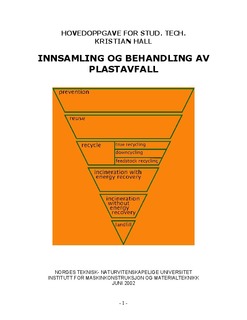| dc.contributor.author | Hall, Kristian | nb_NO |
| dc.date.accessioned | 2014-12-19T12:34:53Z | |
| dc.date.available | 2014-12-19T12:34:53Z | |
| dc.date.created | 2007-03-02 | nb_NO |
| dc.date.issued | 2002 | nb_NO |
| dc.identifier | 122146 | nb_NO |
| dc.identifier.uri | http://hdl.handle.net/11250/242631 | |
| dc.description.abstract | This document is a diploma thesis from the Norwegian University of Science and Technology, Department of Machine Design and Materials Technology, and covers the following research questions:
What is the composition of plastics household waste in Trondheim, Norway, how should it be collected out of the alternative curbside containers plastdunk (container for plastics only) and miljødunk (container for plastics, metal and other fractions not suitable for incineration), and how should it be processed, out of the alternatives mechanical and chemical/feedstock recycling?
The report includes the results from a detailed analysis of the plastics content in the plastdunk, as well as the findings in a literature study of mechanical and feedstock recycling. These are the main conclusions:
- The calculated plastics amount from the examined area of Heimdal in Trondheim, shows an increase of 48%. As this is unlikely, there is probably one or more errors in the analysis from this year, or the similar analysis done last year. This adds some uncertainty to some of the conclusions. The calculated total amount of households plastics in Trondheim per year is 3736 tons. This is a very different amount from the previous estimate of 1174 tons (packaging only). As only 25,4% of the total plastics ends up in the plastdunk, there is a loss of 74,5% of the plastics because of erroneous sorting from consumers.
- Plastic shopping and garbage bags amount to 40,2% of the plastic film fraction. Of the bottle fraction, plastics from dairy products amount to 21,7%, while plastics from packaging of car-maintenance products (motor oil etc.) add up to 33,6%. There is 5,5% more plastics in absolute amounts in the plastdunk compared to the miljødunk. When implementing a curbside system based on the plastdunk in Trondheim, 41% more film and 75% more bottles can be recovered from the wasteflow, compared to the existing system based on the miljødunk. The reason for this is that it is easier to sort plastics from the plastdunk. Thus, I can conclude that the plastdunk is the better alternative compared to th miljødunk.
- A comparison of the environmental properties of the alternatives mechanical and feedstock recycling shows that mechanical recycling has the least environmental load. Comparing by total costs shows that the two alternatives cost roughly the same per ton treated, while feedstock recycling has the better potential for cost savings over time, as technology progresses. The cost-data involve a fair degree of uncertainty. The smallest facilities for feedstock recycling, with a annual capacity of 15 000 tons, are based on the method of BASF thermolysis. This method has a relatively low environmental load. However, the method demands a refinery for its products. Summing up, the report concludes that feedstock recycling is unsuitable for plastics from households in Trondheim. | nb_NO |
| dc.description.abstract | Denne oppgaven forsøker å besvare følgende problemstilling:
Hva er sammensetningen av plast i husholdningsavfallet i Trondheim, hva vil være best måte å samle det inn på ut av alternativene miljødunken og plastdunken, og hvordan bør det behandles, ut av de kartlagte alternativene mekanisk resirkulering og kjemisk gjenvinning?
Problemstillingen besvares både eksperimentielt, ved at det utføres en plukkanalyse av plast- og restavfallet fra et prøveområde på Heimdal i Trondheim, og ved et litteraturstudium av mekanisk resirkulering og kjemisk gjenvinning. Følgende viktige konklusjoner kommer frem i oppgaven:
- Beregnet plastmengde fra prøveområdet på Heimdal i 2001 og 2002 viser en økning på 48%. Dette er lite sannsynlig, slik at det trolig eksisterer én eller flere feilkilder i plukkanalysene enten fra i år eller fra i fjor. Dette medfører usikkerhet i en del av konklusjonene. Det strømmer årlig 3736 tonn husholdningsplast gjennom Trondheim, dette i kontrast til tidligere anslag på 1174 tonn (kun emballasje). Kun 25,4% av plasten havner i plastdunken, man har med andre ord en feilsorteringsgrad på 74,5% fra forbruker.
- Bæreposer og søppelsekker utgjør til sammen 40,2% av all plastfolien fra Trondheims husholdninger, av hardplastemballasjen er det plast fra meieriindustrien (21,7% av all hardplastemballasje) og verkstedindustrien (33,6%) som utgjør de største enkeltkildene. I absolutte mengder (tonn) er det 5,5% mer plast i plastdunken enn i miljødunken. Med et plastdunk-hentesystem i hele Trondheim vil man få hentet ut 41% mer plastfolie og 75% mer hardplast enn med miljødunksystemet. Dette fordi det er lettere å sortere ut plast fra plastdunken enn miljødunken. Ut fra disse to fakta kan jeg konkludere med at plastdunken er et bedre alternativ enn miljødunken.
- Sammenliknet etter miljøytelse kommer mekanisk resirkulering best ut. Sammenliknet etter kostnader kommer alternativene omtrent like bra ut med tilgjengelig teknologi av i dag, mens kjemisk gjenvinning har et større potensial for reduksjon av kostnader. Kostnadsdataene innebærer en del usikkerhet. De minste anleggene for kjemisk gjenvinning har en årlig kapasitet på 15 000 tonn, og benytter metoden BASF termolyse, som yter bra miljømessig. Anlegget trenger imidlertid tilgang til et raffineri i relativ nærhet. En samlet vurdering tilsier at mekanisk resirkulering er et bedre alternativ i Trondheim. | nb_NO |
| dc.language | nor | nb_NO |
| dc.publisher | Norges teknisk-naturvitenskapelige universitet, Fakultet for ingeniørvitenskap og teknologi, Program for industriell økologi | nb_NO |
| dc.title | Innsamling og behandling av plastavfall | nb_NO |
| dc.type | Master thesis | nb_NO |
| dc.contributor.department | Norges teknisk-naturvitenskapelige universitet, Fakultet for ingeniørvitenskap og teknologi, Program for industriell økologi | nb_NO |
